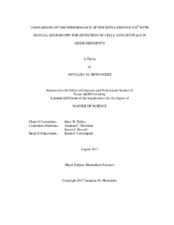| dc.description.abstract | Microscopic evaluation of urine sediments is underutilized in veterinary clinics. The IDEXX SediVue Dx® Urine Sediment Analyzer (SediVue) has been recently introduced for automated analysis of canine and feline urine. The objective of this study was to compare the performance of the SediVue with manual microscopy for detecting clinically significant numbers of cells and crystals.
Five hundred thirty-four urine samples (81% canine, 19% feline) were evaluated. For SediVue analysis (1.0.0.0 and 1.0.1.3), 165 μL of well-mixed, uncentrifuged urine was pipetted into a disposable cartridge. Seventy high-resolution images were captured and processed using a veterinary-specific neural network algorithm. For manual microscopy, urine was centrifuged to obtain sediment. Red blood cells (RBC), white blood cells (WBC), squamous epithelial cells (EPI), and non-squamous epithelial cells (NEC) were quantified by averaging the number of cells in 10 high power fields (HPF), while struvite crystals (TRI) and calcium oxalate dihydrate crystals (CaOxd) were placed into a semi-quantitative category. For clinical significance, a threshold of ≥ 5/HPF was used for RBC and WBC, while a threshold of ≥ 1/HPF was used for epithelial cells and crystals. Using these thresholds, sensitivity and specificity of the SediVue for formed element detection were determined as compared to manual microscopy.
The sensitivity of the SediVue (1.0.1.3) was good for detection of RBC, WBC, and TRI; moderate for CaOxd; fair for NEC; and poor for EPI. Specificity was excellent for EPI and CaOxd; good for RBC, WBC, and NEC; and moderate for TRI. The newer software version (1.0.1.3) displayed improved sensitivity but decreased specificity for most elements compared to the older version (1.0.0.0). Performance of the Sedivue was overall similar for canine versus feline samples as well as between fresh and stored samples. Precision of the instrument was acceptable.
The SediVue Dx provides diagnostically useful information regarding the presence of clinically significant numbers of formed elements in canine and feline urine and should increase the number of complete urinalyses performed in private practice. Performance is best for RBC, WBC, TRI, and CaOxd, while improvement is needed for epithelial cells. Further software development should continue to enhance accuracy of formed element detection. | en |


